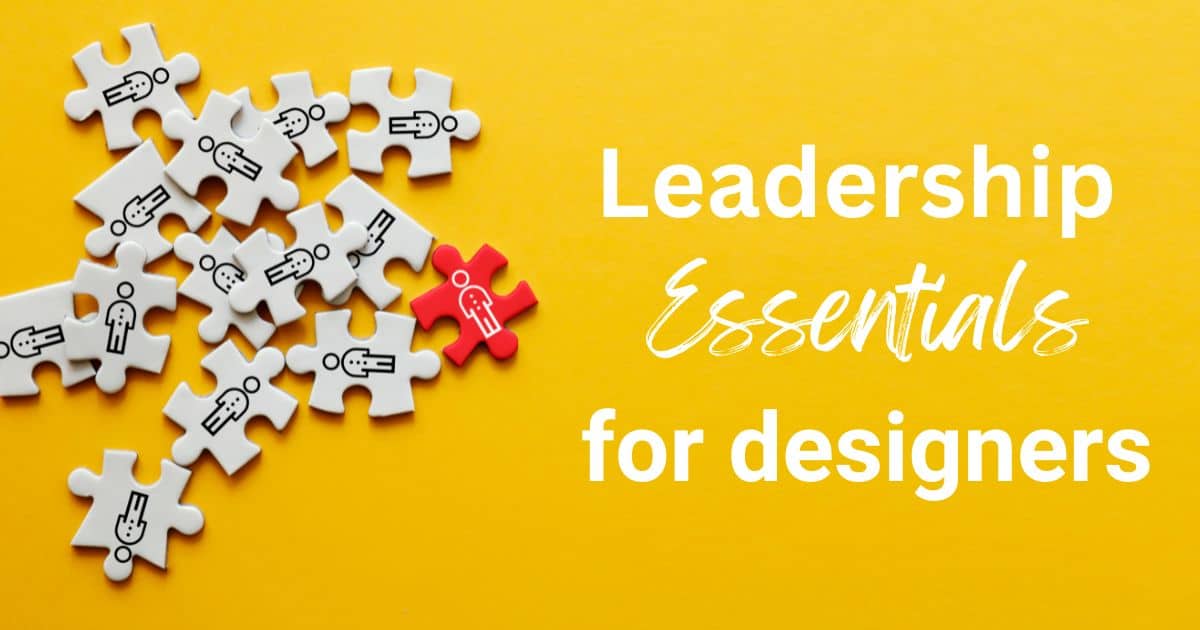We had an exceptional guest on our Design Chats podcast, Brett Macfarlane, an organizational consultant who focuses on leadership development for innovation and change.
Based in Vancouver, he works primarily with tech and creative organizations and counts Visa, Unilever, and Apple among his past clients. (Read his Apple Watch case study.)
We captured highlights from the episode in the below Q&A. (Editor’s note: This conversation has been lightly edited and condensed for clarity.)
Why do you often talk about leadership being a shared responsibility?
In the early stages, when you are the sole contributor on a team, you can still hold a leadership role. There are moments when the team will seek your expertise to solve a problem, or you may contribute by suggesting a better or alternative approach or sharing how your actions impact others.
Leadership is the act of driving change.
It is not a one-way activity but a two-way interaction.
As you progress and assume responsibility for a team, your leadership function becomes shared, and you become accountable for the entire team—not just as a member but also in providing pastoral care for the team.
As you advance, your focus shifts from problem-solving to enabling others to solve problems and supporting them in their endeavors. Consequently, not only do your tasks and practices change, but also how you approach and prioritize them.
However, the most significant shift occurs in your identity. Often, individuals face challenges when they reach senior positions or aspire to have a seat at the table. They overlook the need to shift their identity. Once you attain that position, your role is no longer about campaigning; you are part of the establishment. Embracing this role and working within it while managing any accompanying anxiety is crucial.
Many of us naturally have an anti-establishment bias driven by a desire for improvement and frustration with the status quo. While this optimism is valuable, it is essential to collaborate with others, inviting them in and seeking their input when you sit at the top table.
It’s worth noting that aspiring to that position is not necessary because it represents a different task and job; leadership is about action, not merely a position.
What role do empathy and experience play in leadership?
Empathy has an external application, but effective leaders apply it internally within their organizations. They develop hypotheses to understand why a person expected to contribute significantly is not doing so.
Similarly, they seek to comprehend the reasons behind someone’s disruptive behavior or outbursts rather than simply telling them to stop. It’s natural for many of us to react with anger when faced with certain situations because we often don’t know the underlying causes unless we put in the effort.
Our present leadership style is shaped by our past experiences, and this influence can be both powerful and destructive.
We often remain unaware of the past influencers that impact our present leadership unless we actively explore them. This can include knowledge, past experiences, and pivotal moments in our lives, such as early bosses, influential figures in our community, teachers, school groups, and even our first organization—our family. It’s not to say that everything goes back to our mom and dad, but there are often connections that emerge constantly in the work I do with leaders.
Through various activities and assessments, we evaluate current situations, compare positive and negative moments and employ tools to gain insights.
For example, we might discover that in a specific situation, you felt idealized as a leader, with people expecting you to have perfect solutions as a designer. While part of you might have enjoyed this recognition, another part might have been terrified by it. Consequently, you might have started self-sabotaging, withdrawing or even lashing out.
Through introspection, you might realize that earlier in your career, you had a boss who appeared ideal in public but was actually a terrible bully behind the scenes. This revelation triggers your fear of becoming a bully yourself when you feel idealized, leading to self-destructive behaviors.
Once these patterns and connections surface, it can be a relief. By connecting the dots, a simple path forward becomes apparent. However, it can be challenging to revisit these past experiences and create personal insights. It requires acknowledging, “Ah, I noticed I responded this way, and my inference as to why is tied to an earlier boss or a specific experience with a teacher that triggered my present response based on something that happened in the past.”
It’s important to note that not every annoyance or reaction can be attributed to the past, but as leaders, it’s crucial to identify those hot buttons. Understanding the origin of your superpower, its limits, and when it veers into harmful territory allows for responsible and impactful leadership.
How can leaders instill psychological safety on their teams?
Regarding psychological safety and empowerment, it’s not enough to simply claim that someone is safe or empowered. It requires understanding the situation and allowing space for uncertainty, anxiety, and frustration to surface.
By “allow,” I don’t mean tolerating these emotions as the norm, but rather being empathetic. It’s about recognizing that if you were in their position, you might also feel frustrated, skeptical, doubtful, worried or hold a different point of view.
As a leader, you must acknowledge and address these emotions and uncertainties, not just assume power. It’s about embracing and sharing the uncertainty. It can be expressed as saying, “We’ve tried this before, and it didn’t work, so I’m skeptical.”
In response, you show gratitude for their perspective and initiate a discussion to unpack the reasons behind it. This is part of your responsibility as a leader to engage with and process these emotions and thoughts. Valuable information may emerge, or it could be an opportunity to reassure and support the individual who is genuinely scared and needs comfort to work through their concerns.
In highly innovative and emotionally charged situations, there’s a lot at stake—not only from a commercial perspective, but also on a personal level. It could impact roles, jobs, or performance evaluations. It can also affect self-image and identity.
How should leaders empower their teams?
In a literal sense, you can practice these six strategies for empowerment:
- Question critical assumptions: This practice helps reassure individuals through words of affirmation. It focuses on highlighting their strengths and what they are capable of rather than dwelling on limitations.
- Seek different perspectives: By encouraging individuals to seek different perspectives helps them build confidence in their creative thinking abilities and builds linkage.
- Share valuable life lessons: Sharing personal vulnerability and authenticity is crucial. Understanding that others experienced similar situations provides reassurance and may offer relevant insights. It’s an effective teaching tactic that goes beyond mere instructions.
- Introduce followers to development opportunities: When a leader steps up, it becomes an opportunity for career development. Creating space for their growth while ensuring the comfort of others fosters a supportive environment and boosts team morale.
- Present different perspectives: This practice involves exposing one’s analytical and problem-solving practices. It’s about modeling and providing alternative viewpoints, not giving recommendations or directives. It encourages lateral thinking and expands the individual’s perspective, increasing creativity and ownership.
- Foster ownership and creativity: The goal is to offer individuals small gifts or insights they can pick up and transform into something remarkable. Recognizing that most people possess extraordinary capabilities, these practices serve as keys to unlocking their full potential.
“How can design leaders navigate the different roles they’re asked to perform?”
Charismatic leadership encompasses empowering, envisioning and energizing. Architectural leadership involves designing, rewarding and controlling systems and organizational components.
Designers often excel in the charismatic aspect, empowering others through visions, prototypes, ideas and inspiring research insights. They are skilled at energizing people throughout the process. Design meetings are often perceived as the most exciting part of organizations.
However, it’s equally important for designers to develop awareness and skills in the architectural role as they advance in their careers. As individuals progress to senior leadership positions, the ability to switch between these roles or at least be aware of them becomes crucial.
For broader organizational leadership roles, whether in corporate or board settings, it’s essential not to disengage when discussions shift toward compensation systems, market strategies or other architectural aspects.
Some designers may even immerse themselves in areas like supply chain management, demonstrating their interest in the architectural role. However, it’s worth noting that charismatic and architectural leadership traits are often found in different individuals, with some excelling naturally in one aspect over the other.
Being self-reflective and aware of your inclinations allows for the development of complementary skills or the recognition of when to collaborate and leverage the strengths of others.
It’s a valuable realization that, while trying to add value in areas outside your natural inclination, there’s also an opportunity to let others shine in their respective roles. By combining the strengths of charismatic and architectural leadership, a powerful duo can be formed, leading to exceptional outcomes.
Can you expand on the importance of self-awareness in leadership?
Self-awareness is closely related to transformative leadership. Transformative leadership involves helping others self-motivate, while authentic leadership entails being self-aware of one’s motivations and effectively communicating them to foster understanding and build trust.
Understanding the experiences and motivations of others provides deeper comprehension than relying solely on logical explanations. Sharing why one is excited, worried, or concerned about a certain aspect—whether based on logic or personal experience—is a powerful way to build trust.
Reflecting on your data and understanding personal motivations are essential to authentic leadership. It involves comprehending not only intrinsic motivation but also the reasons behind it.
To explore these motivations, I use a tool called the Innovation Leadership Map, which examines six dimensions: outlook, identity, exposure, empowerment, risk, and actualization. By analyzing good and bad leadership experiences, similar to how athletes review their performance, we can gain insights into our behaviors.
A significant part of this process is conducting a leadership biography, reflecting on leadership role models and experiences at different stages of life. This exercise often reveals imprints of good or bad leadership and helps explain confounding behaviors in leadership roles.
The analysis of these experiences requires identifying three primary motivating anxieties: control anxiety, validation anxiety, and death anxiety (the desire for a legacy). Anxiety, in this context, refers to motivation.
Understanding your motivating anxieties and their associated experiences helps explain frustration, energy loss and suboptimal performance. Personally articulating these motivations, such as the need for validation, safety, or a sense of legacy, creates a personal connection with others and demonstrates authenticity and self-awareness. Sharing these motivations allows others to understand the driving forces behind your decisions and actions.
Developing a personal leadership archetype is a powerful aspect of leadership development. This archetype is slightly detached from one’s true self, enabling experimentation and playfulness.
It helps align personal energy and strengths, identify areas for improvement, and decide whether to develop weaknesses or focus on strengths. Leaders can create a concrete practice plan by envisioning the endpoint and collecting data to understand the current state.
Hone Your Design Leadership Skills in Pragmatic’s Business Strategy and Design Course
Discover how to connect your design work to your company’s business strategy, demonstrate the design’s return on investment, and contribute to strategic conversations. Pragmatic Institute’s comprehensive program empowers designers with the knowledge, tools, and vocabulary needed to align their user-centered approach with key business objectives.
Course Highlights:
- Gain a solid grounding in business strategy and its key components
- Learn to translate your company’s business strategy into design priorities
- Effectively communicate the business value of design to stakeholders
- Balance desirability and viability in your design decisions
- Measure the impact of your design work and connect it to business goals
Author
-

The Pragmatic Editorial Team comprises a diverse team of writers, researchers, and subject matter experts. We are trained to share Pragmatic Institute’s insights and useful information to guide product, data, and design professionals on their career development journeys. Pragmatic Institute is the global leader in Product, Data, and Design training and certification programs for working professionals. Since 1993, we’ve issued over 250,000 product management and product marketing certifications to professionals at companies around the globe. For questions or inquiries, please contact [email protected].
View all posts







